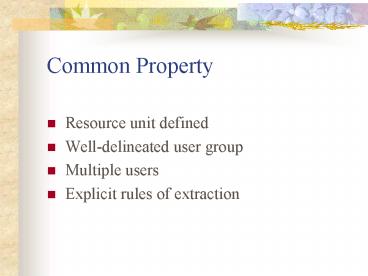Common Property - PowerPoint PPT Presentation
1 / 26
Title:
Common Property
Description:
Particular spatial distribution creates asymmetries. Upstream-downstream ... Problem of property rights, efficiency and externalities raised by Coase ... – PowerPoint PPT presentation
Number of Views:68
Avg rating:3.0/5.0
Title: Common Property
1
Common Property
- Resource unit defined
- Well-delineated user group
- Multiple users
- Explicit rules of extraction
2
Why Common Property?
- Nature of resource
- Economies of scale
- Maintenance or capital demands
- Enforcement
3
The Example of water
- Common good aspects
- Competitive use
- Particular spatial distribution creates
asymmetries - Upstream-downstream
- Common pool technology differences lead to
differential access - Unequal political power
- International aspects compound problems
4
Debates about water
- Debate over nature of resource
- Symbolic aspects natural right
- Water as economic good
- Debate about most effective management strategies
5
Nature of resource debate
- Symbolic aspects natural right
- Open access?
- BUT
- Demographic growth
- Urbanization concentration of demand
- Agricultural intensification
- 70 of water used for irrigation
- Changing demands economic development
- Quality/quantity
- Health issues water borne diseases
- Pollution overuse and salinization
6
Nature of resource debate
- Water as commodity evaluate costs
- Supply costs exploitation, maintenance,
investments - Opportunity costs
- Externalities
- Goal promote efficiency and avoid "tragedy of
commons" type outcome
7
Management problems
- How to balance equity issues raised by "right to
water" approach with efficiency aspects raised by
"water as commodity" view?
8
Example Central Asia
9
A view of the problem
Aral Sea 1985
Aral Sea 1997
10
Causes of shrinking Aral Sea
- Since 19e century, Russia, and later Soviet Union
emphasized cash crops cotton and rice - Reduce dependence on imports
- Acquire hard currency
- After 1960, consequence of policy was reduction
in volume of water flowing to Aral Sea
11
Soviet system
- Quotas specifying quantities of water available
for each region - Exchange fossil fuels and energy for water
- Coordination by central government
12
Present context
- Water allocation is no longer a domestic issue
within a centralized state but has become an
international problem - New source of conflict
13
Current management structure
- Almaty Agreement 1992
- Based on former Soviet allocation system
- Creation of interstate commission where decisions
taken by consensus - Establish quotas
- Assure their implementation
14
Management problems
- Maintenance of old Soviet system
- Not all states accept previous allocation
criteria - Favors richer downstream countries
- Enforcement problems quotas not respected
- Exchanges between energy and water have been
maintained but also not always respected
15
Persisting common good problems
- Lack of information on quantities really
available - Thus cannot determine sustainable rate of use
- Costs of water use not distributed fairly
- Downstream users of Toktogul dam do not
contribute to maintenance costs
16
Reaction
- After independence , Uzbekistan and Kazakstan
introduced market prices for gas and coal. - Kyrgyzstan couldn't pay increased electricity
production to increase revenues - But then the amount of water available for
downstream irrigation in Uzbekistan and Kazakstan
was also reduced
17
Response
- 2001 Kyrgyzstan passed law to regulate
transborder water use - Water belongs to state
- Has economic value
- Kyrgyzstan owns water "created" within it borders
- Users must pay
18
Water International efforts
- Dublin Conference and Rio Summit, 1992
- Broad often contradictory principles
- Slow definition of international water law UN
Convention 1997 on non-navigational uses
19
Relevance of different property regimes to other
current environmental issues
- Confrontation of regimes is occurring
- South/North
- Common property characteristics of environmental
resources - Institutional solutions that adopt common
property arrangements
20
Efficiency, the Environment and Property Rights
- What is efficiency in economic, social,
environmental, and technical terms? - Are they equivalent?
- What is the relation with property rights?
- Is the problem simple to solve?
21
Efficiency
- Economic and social efficiency use resources in
such a way that they minimize costs and maximize
profits - Technical efficiency minimizing inputs with
respect to outputs ? minimizing energy use - There should not be any contradiction between the
2 above - If contradiction not internalized externality,
ill defined property rights
22
The Coasian analysis
- Problem of property rights, efficiency and
externalities raised by Coase - Argument What matters is the overall cost and
benefit - Compensation schemes can be built around this
principle - It depends who has the biggest loss
- The issue can be resolved by negotiation
- All allocations based on Coasian principle
optimal
23
What do property rights provide?
- Demsetz claims that they are an internalization
of externalities - Adjustment of property rights are an adjustment
to externalities - Example forced labor
- Property rights originate when there are
environmental scarcities
24
Problems raised by Dasgupta and Heal
- Property rights are not created in a vacuum
- Problem often comes from partially defined
property rights - Coase and Demsetz assume symmetry which might not
exist - They implicitly assume unique equilibrium
- Problem Multiple equilibria
25
Multiple equilibria
26
Solutions
- In these cases, solutions have to be revealed to
producers - Sometimes solutions have to be imposed





![3 Common Myths of Property Styling [Debunked] PowerPoint PPT Presentation](https://s3.amazonaws.com/images.powershow.com/9349608.th0.jpg?_=20191017050)

























